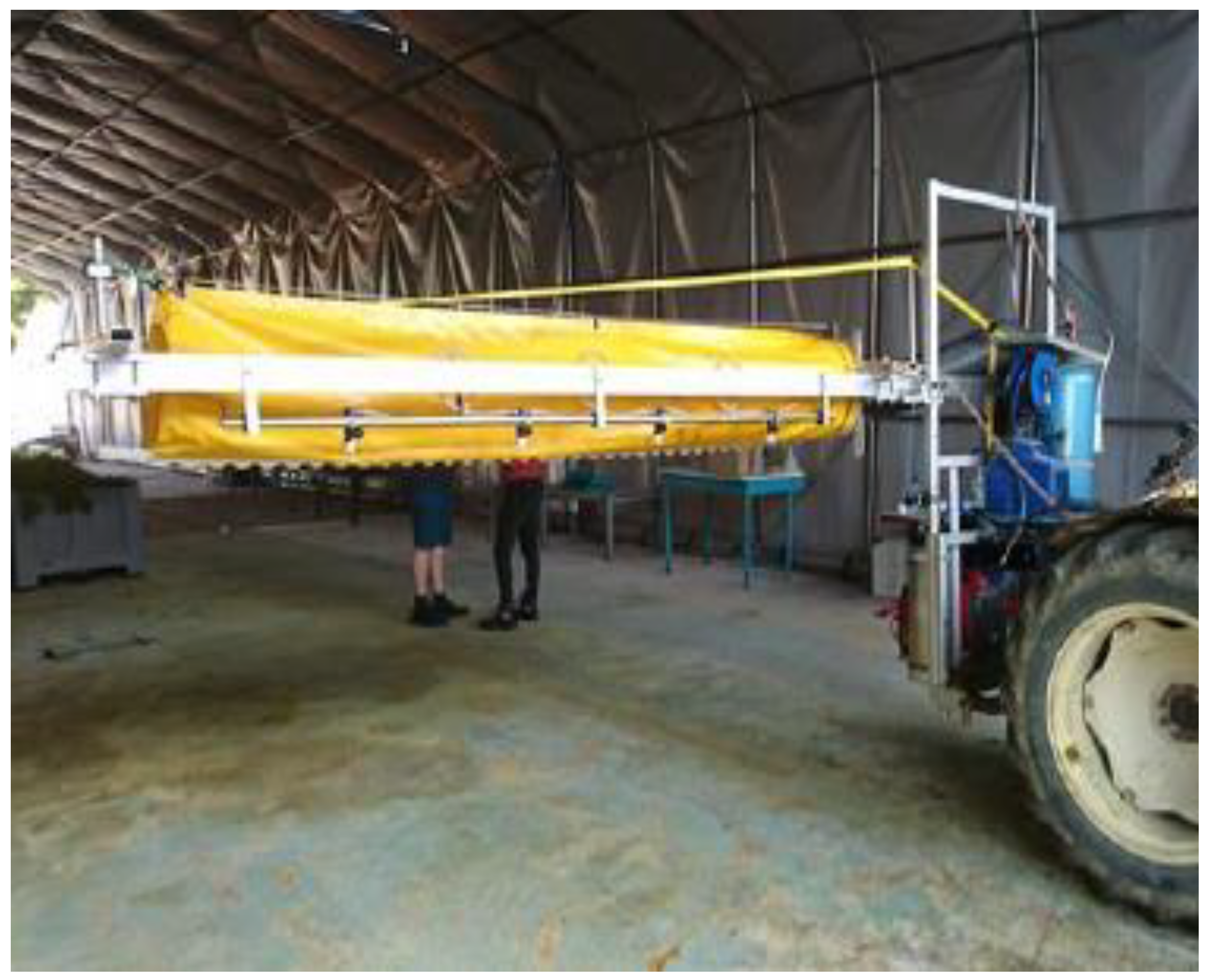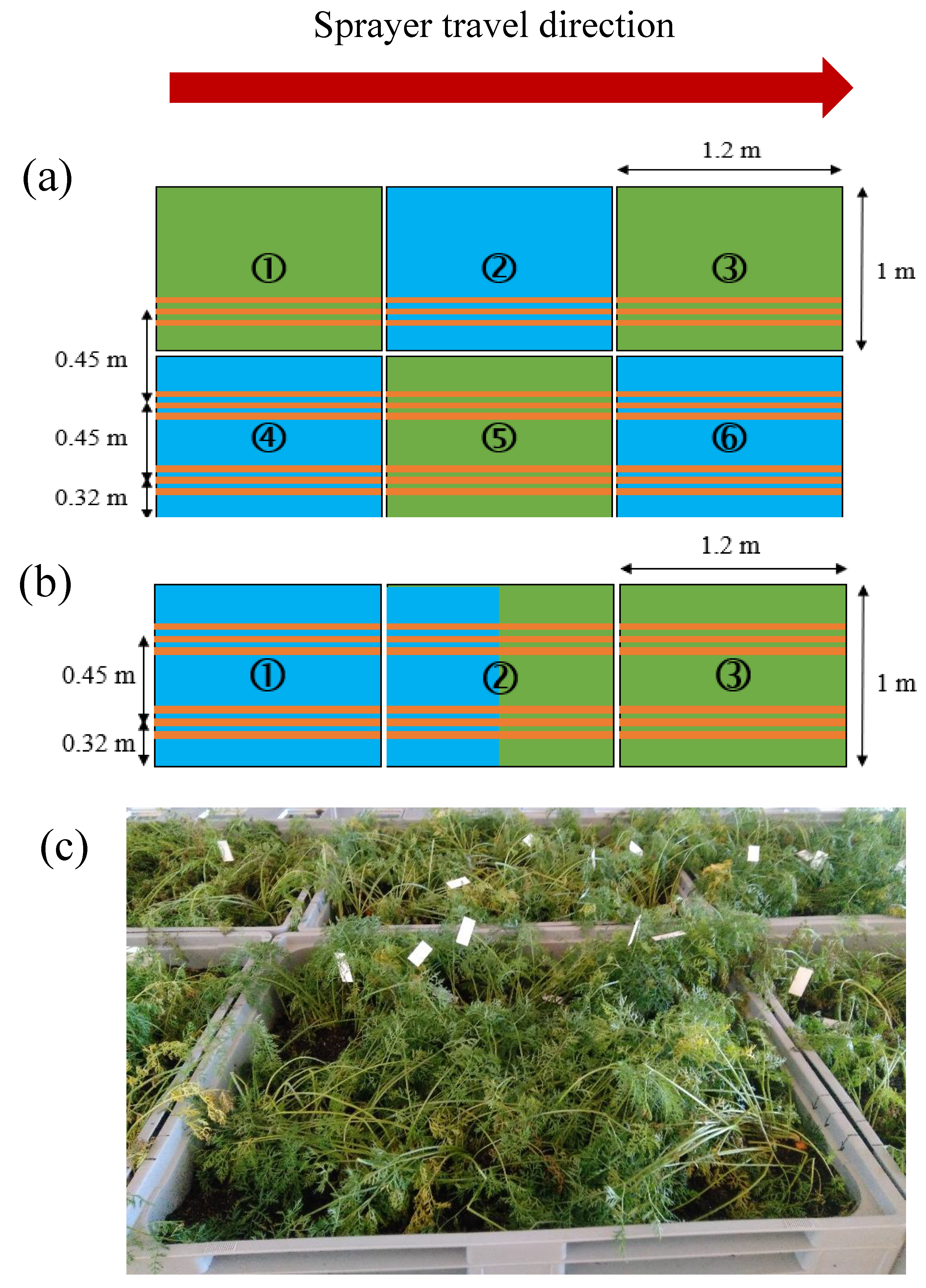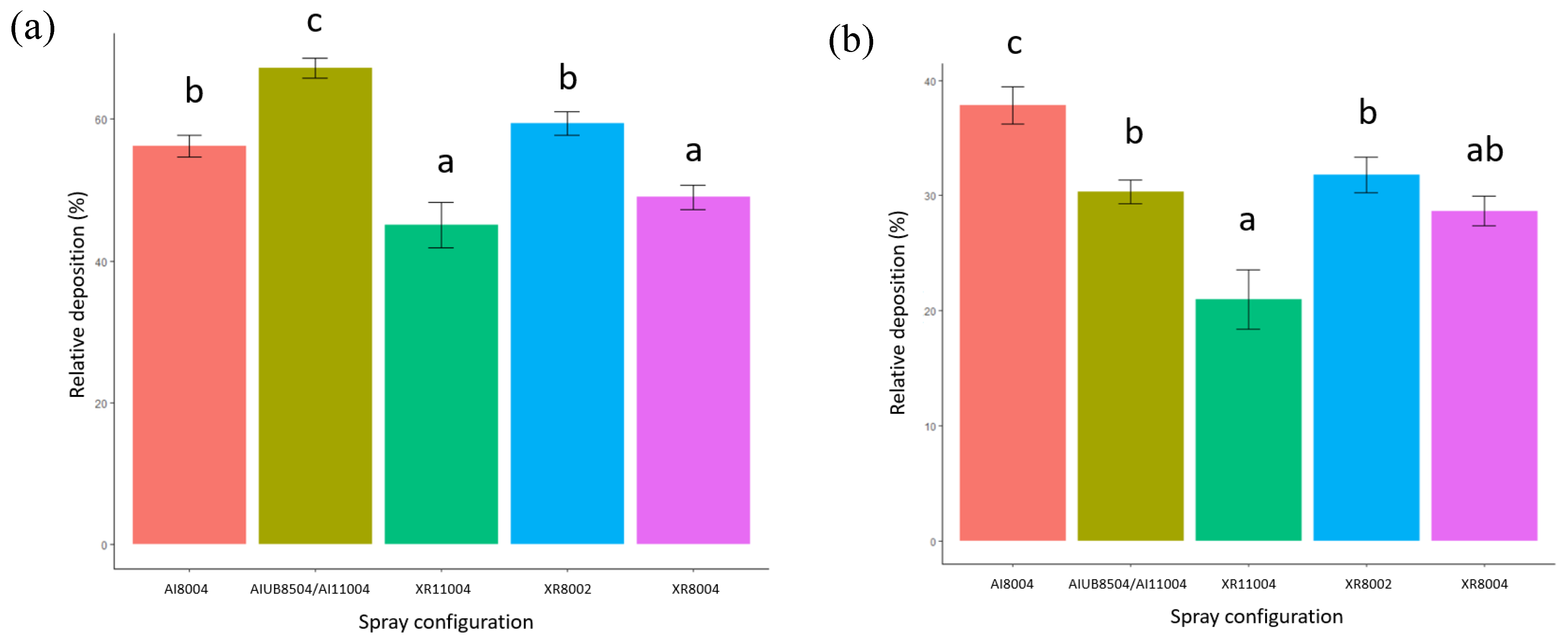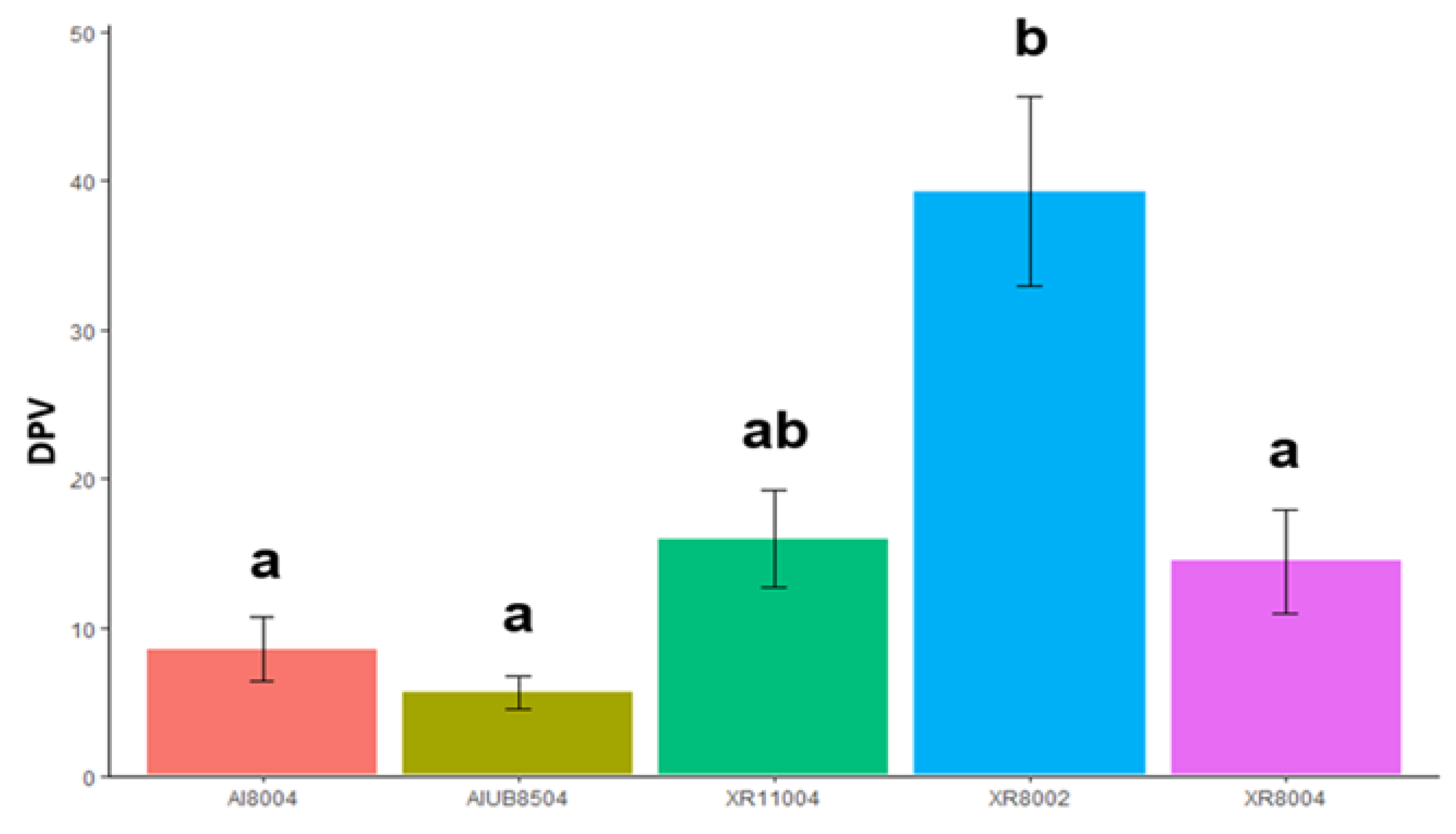Performance of a Prototype Boom Sprayer for Bed-Grown Carrots Based on Canopy Deposition Optimization, Ground Losses and Spray Drift Potential Mitigation in Semi-Field Conditions
Abstract
:1. Introduction
2. Materials and Methods
2.1. Spray Boom Equipment
2.2. Sprayer Configurations and Spray Settings
2.3. Spray Deposition
2.3.1. Crop Characteristics
2.3.2. Spray Deposition Assessment
2.4. Spray Drift Potential
2.4.1. Experimental Drift test Bench Setup
2.4.2. Drift Potential Value (DPV)
2.5. Statistical Analysis
3. Results
3.1. Canopy Deposition on Full-Grown Carrots
3.2. Ground Losses on Full-Grown Carrots
3.3. Canopy Deposition on Early-Stage Carrots
3.4. Spray Drift Potential
4. Conclusions
Author Contributions
Funding
Institutional Review Board Statement
Informed Consent Statement
Data Availability Statement
Acknowledgments
Conflicts of Interest
References
- Cook, E. (Ed.) Agriculture, Forestry and Fishery Statistics: 2020 Edition; Publications Office of the European Union: Luxembourg, 2020; Available online: https://ec.europa.eu (accessed on 1 April 2022).
- Bender, I.; Edesi, L.; Hiiesalu, I.; Ingver, A.; Kaart, T.; Kaldmäe, H.; Talve, T.; Tamm, I.; Luik, A. Organic Carrot (Daucus carota L.) Production Has an Advantage over Conventional in Quantity as Well as in Quality. Agronomy 2020, 10, 1420. [Google Scholar] [CrossRef]
- Vintal, H.; Ben-Noon, E.; Shlevin, E.; Yermiyahu, U.; Shtienberg, D.; Dinoor, A. Influence of rate of soil fertilization on Alternaria leaf blight (Alternaria dauci) in carrots. Phytoparasitica 1999, 27, 193–200. [Google Scholar] [CrossRef]
- Nuyttens, D.; Braekman, P.; Windey, S.; Sonck, B. Potential dermal pesticide exposure affected by greenhouse spray application technique. Pest Manag. Sci. 2009, 65, 781–790. [Google Scholar] [CrossRef] [PubMed]
- Kuster, C.J.; Hewitt, N.J.; Butler Ellis, C.; Timmermann, C.; Anft, T. Measurements of the dermal exposure to bystanders from direct off-crop drift during the application of plant protection products. Ann. Appl. Biol. 2021, 179, 123–133. [Google Scholar] [CrossRef]
- Kjær, C.; Strandberg, M.; Erlandsen, M. Effects on hawthorn the year after simulated spray drift. Chemosph 2006, 63, 853–859. [Google Scholar] [CrossRef]
- European Commission. EU Policy for a Sustainable Use of Pesticides: The Story Behind the Strategy; European Commission: Brussel, Belgium, 2007. [Google Scholar]
- Hefner, M.; Labouriau, R.; Norremark, M.; Kristensen, H.L. Controlled traffic farming increased crop yield, root growth, and nitrogen supply at two organic vegetable farms. Soil Till. Res. 2019, 191, 117–130. [Google Scholar] [CrossRef]
- Wightman, B.; Peries, R.; Bluett, C.; Johnston, T. Permanent raised bed cropping in southern Australia: Practical guidelines for implementation. In Proceedings of the Workshop on Evaluation and Performance of Permanent Raised Bed Cropping Systems in Asia, Australia and Mexico, Griffith, NSW, Australia, 1–3 March 2005; Roth, C.H., Fischer, R.A., Meisner, C.A., Eds.; The Australian Centre for International Agricultural Research (ACIAR): Canberra, Australia, 2005. [Google Scholar]
- Johansen, T.J.; Thomsen, M.G.; Løes, A.-K.; Riley, H. Root development in potato and carrot crops—Influences of soil compaction. Acta Agric. Scand. Sect. B-Soil Plant Sci. 2015, 65, 182–192. [Google Scholar] [CrossRef]
- Ryan, K. Growing the Apiaceae (Carrot) Family; Washington State University: Washington, DC, USA, 2015; Available online: https://extension.wsu.edu/snohomish/apiaceae/ (accessed on 1 April 2022).
- Rohwer, C.L. Carrot Yield and Shape Altered by Seeding Rate and Raised Beds in Clay-loam Soil. HortScience 2021, 56, 722–729. [Google Scholar] [CrossRef]
- Bakker, D.M.; Hamilton, G.J.; Houlbrooke, D.J.; Spann, C. The effect of raised beds on soil structure, waterlogging, and productivity on duplex soils in Western Australia. Soil Res. 2005, 43, 575–585. [Google Scholar] [CrossRef]
- Hassan, I.; Hussain, Z.; Akbar, G. Effect of permanent raised beds on water productivity for irrigated maize–Wheat cropping system. In Proceedings of the Workshop on Evaluation and Performance of Permanent Raised Bed Cropping Systems in Asia, Australia and Mexico, Griffith, NSW, Australia, 1–3 March 2005; Roth, C.H., Fischer, R.A., Meisner, C.A., Eds.; The Australian Centre for International Agricultural Research (ACIAR): Canberra, Australia, 2005; pp. 59–65. [Google Scholar]
- Rady, M.O.; Semida, W.M.; Howladar, S.M.; Abd El-Mageed, T.A. Raised beds modulate physiological responses, yield and water use efficiency of wheat (Triticum aestivum L.) under deficit irrigation. Agric. Water Manag. 2021, 245, 106629. [Google Scholar] [CrossRef]
- Giles, D.K.; Slaughter, D.C. Precision band spraying with machine-vision guidance and adjustable yaw nozzles. Trans ASAE 1997, 40, 29–36. [Google Scholar] [CrossRef]
- van de Zande, J.C.; Achten, V.T.; Schepers, H.T.; Lans, A.V.D.; Kempenaar, C.; Michielsen, J.M.G.; Velde, P.V. Precision disease control in bed-grown crops. In Precision Crop Protection—The Challenge and Use of Heterogeneity; Springer: Dordrecht, The Netherlands, 2010; pp. 403–415. [Google Scholar] [CrossRef]
- Holterman, H.J.; van de Zande, J.C.; van Velde, P. Optimizing sprayer boom design for bed-grown crops. Int. Adv. Pest Appl. 2018, 137, 123–130. [Google Scholar]
- Michielsen, J.M.G.P.; De Hoog, D.C.; Snoussi, M.; Stallinga, H.; van de Zande, J.C. Spray deposition of an optimised Canopy Density Spraying boom design in a bed-grown crop. Int. Adv. Pest Appl. 2020, 144, 131–138. [Google Scholar]
- Zwertvaegher, I.; Lamare, A.; Douzals, J.P.; Balsari, P.; Marucco, P.; Grella, M.; Caffini, A.; Mylonas, N.; Dekeyser, D.; Foqué, D.; et al. Boom sprayer optimizations for bed-grown carrots at different growth stages based on spray distribution and droplet characteristics. Pest Manag. Sci. 2022, 78, 1729–1739. [Google Scholar] [CrossRef] [PubMed]
- Balsari, P.; Paolo, M.; Mario, T. A Test Bench for the Classification of Boom Sprayers According to Drift Risk. Crop Prot. 2007, 26, 1482–1489. [Google Scholar] [CrossRef]
- Wolf, T.M.; Peng, G. Improving Spray Deposition on vertical structures: The role of nozzle angle, boom height, travel speed, and spray quality. Pest Technol. 2021, 5, 67–72. [Google Scholar]
- Southcombe, E.S.E.; Miller, P.C.H.; Ganzelmeier, H.; van de Zande, J.C.; Miralles, A.; Hewitt, A.J. The international (BCPC) spray classification system including a drift potential factor. In Proceedings of the Brighton Crop Protection Conference—Weeds, Brighton, UK, 17–20 November 1997; pp. 371–380. [Google Scholar]
- Spillman, J.J. Spray impaction, retention and adhesion: An introduction to basic characteristics. Pest Sci. 1984, 15, 97–106. [Google Scholar] [CrossRef]
- Matthews, G.A. Pesticide Application Methods, 3rd ed.; Blackwell Science: Oxford, UK, 2000. [Google Scholar]
- Zwertvaegher, I.K.; Verhaeghe, M.; Brusselman, E.; Verboven, P.; Lebeau, F.; Massinon, M.; Nicolaï, B.M.; Nuyttens, D. The impact and retention of spray droplets on a horizontal hydrophobic surface. Biosyst. Eng. 2014, 126, 82–91. [Google Scholar] [CrossRef] [Green Version]
- Nordbo, E. Effects of nozzle size, travel speed and air assistance on deposition on artificial vertical and horizontal targets in laboratory experiments. Crop Prot. 1992, 11, 272–278. [Google Scholar] [CrossRef]
- Cooke, B.K.; Hislop, E.C.; Herrington, P.J.; Western, N.M.; Humpherson-Jones, F. Air-assisted spraying of arable crops, in relation to deposition, drift and pesticide performance. Crop Prot. 1990, 9, 303–311. [Google Scholar] [CrossRef]
- Gan-Mor, S.; Grinstein, A.; Beres, H.; Riven, Y.; Zur, I. Improved uniformity of spray deposition in a dense plant canopy: Methods and equipment. Phytoparasitica 1996, 24, 57–67. [Google Scholar] [CrossRef]
- Van De Zande, J.C.; Michielsen, J.M.G.P.; Stallinga, H.; Porskamp, H.A.J.; Holterman, H.J.; Huijsmans, J.F.M. Spray distribution when spraying potatoes with a conventional or an air-assisted field boom sprayer. In Proceedings of the 2002 ASAE Annual Meeting, Chicago, IL, USA, 28–31 July 2002; American Society of Agricultural and Biological Engineers: St. Joseph, MI, USA, 2002; p. 1. [Google Scholar]
- Ozkan, H.E.; Zhu, H.; Derksen, R.C. Evaluation of spraying equipment for effective application of fungicides to control Asian Soybean Rust. In Proceedings of the 2006 ASAE Annual Meeting, Boston, MA, USA, 19–22 August 2006; American Society of Agricultural and Biological Engineers: St. Joseph, MI, USA, 2006; p. 1. [Google Scholar]
- Foqué, D.; Nuyttens, D. Effect of air support and spray angle on coarse droplet sprays in ivy pot plants. Trans. ASABE 2011, 54, 409–416. [Google Scholar] [CrossRef]
- Gupta, P.; Sirohi, N.P.S.; Kashyap, P.S. Effect of nozzle pressure, air speed, leaf area density and forward speed on spray deposition in simulated crop canopy. Ann. Hort. 2011, 4, 72–77. [Google Scholar]
- Prado, E.P.; Raetano, C.G.; Aguiar Júnior, H.O.; Dal Pogetto, M.H.F.A.; Christovam, R.S.; Gimenes, M.J.; Araújo, D. Effect of the Air Speed in Sleeve Boom on Pesticide Spray Deposition, Severity and Soybean Crop Yield. Summa Phytopathol. 2010, 36, 45–50. [Google Scholar] [CrossRef]
- Nuyttens, D.; Dekeyser, D.; De Schampheleire, M.; Baetens, K.; Sonck, B. The effect of air support on droplet characteristics and spray drift. Commun. Agric. Appl. Biol. Sci. 2007, 72, 71. [Google Scholar]
- van de Zande, J.C.; Huijsmans, J.F.M.; Porskamp, H.A.J.; Michielsen, J.M.G.P.; Stallinga, H.; Holterman, H.J.; de Jong, A. Spray techniques: How to optimise spray deposition and minimise spray drift. Environmentalist 2008, 28, 9–17. [Google Scholar] [CrossRef] [Green Version]
- Taylor, W.A.; Womac, A.R.; Miller, P.C.H.; Taylor, B.P. An attempt to relate drop size to drift risk. In Proceedings of the International Conference on Pesticide Application for Drift Management, Waikoloa, HI, USA, 27–29 October 2004; Washington State University: Pullman, WA, USA, 2004; pp. 210–223. [Google Scholar]
- Gil, E.; Balsari, E.; Gallart, M.; Llorens, J.; Marucco, P.; Andersen, P.G.; Fàbregas, X.; Jordi Llop, J. Determination of Drift Potential of Different Flat Fan Nozzles on a Boom Sprayer Using a Test Bench. Crop Prot. 2014, 56, 58–68. [Google Scholar] [CrossRef]
- Arvidsson, T.; Bergström, L.; Kreuger, J. Spray drift as influenced by meteorological and technical factors. Pest Manag. Sci. 2011, 67, 586–598. [Google Scholar] [CrossRef]
- Nuyttens, D.; De Schampheleire, M.; Baetens, K.; Sonck, B. The influence of operator controlled variables on spray drift from field crop sprayers. Trans. ASABE 2007, 50, 1129–1140. [Google Scholar] [CrossRef]
- Taylor, W.A.; Anderson, P.G.; Cooper, S. The use of air assistance in a field crop sprayer to reduce drift and modify drop trajectories. In Proceedings of the Brighton Crop Protection Conference, Weeds, Brighton, UK, 20–23 November 1989; pp. 631–639. [Google Scholar]






| Application | Nozzles (N) | Air Support (m s−1) | Nozzle Height/Spacing (m/m) | Application Rate (l ha−1) a | ||
|---|---|---|---|---|---|---|
| Deposition on Full-Grown Carrots | Deposition on Early-Stage Carrots | Drift Potential | ||||
| Reference broadcast application | XR 110 04 (4) | 0 | 0.50/0.50 | 0.50/0.50 | 0.50/0.50 | 158 b |
| Bed spray application | XR 80 04 (4) | 0 | 0.60/0.60 | 0.40/0.40 | 0.60/0.60 | 135 c |
| 4 | ||||||
| 8 | ||||||
| AI 80 04 (4) | 0 | 0.60/0.60 | 0.40/0.40 | 0.60/0.60 | 135 c | |
| 4 | ||||||
| 8 | ||||||
| XR 80 02 (4) | 0 | 0.60/0.60 | 0.40/0.40 | 0.60/0.60 | 68 c | |
| 4 | ||||||
| 8 | ||||||
| AIUB 85 04 (2) + AI 110 04 (2) | 0 | 0.60/0.60 | 0.45/0.45 | 0.60/0.60 | 135 d | |
| 4 | ||||||
| 8 | ||||||
| Spray Configuration a | Temperature (°C) Mean ± s.d. | Relative Humidity (%) Mean ± s.d. | |
|---|---|---|---|
| Deposition Full-grown carrots | XR 110 04 | 18.4 ± 2.9 | 81.0 ± 12.7 |
| AI 80 04 | 15.5 ± 0.5 | 51.0 ± 2.8 | |
| XR 80 04 | 18.0 ± 1.1 | 68.8 ± 5.9 | |
| XR 80 02 | 11.6 ± 1.4 | 87.5 ± 7.9 | |
| AIUB 85 04/AI 110 04 | 10.2 ± 1.5 | 68.3 ± 6.8 | |
| Deposition Early-stage carrots | XR 110 04 | 13.1 ± 0.2 | 53.0 ± 1.0 |
| AI 80 04 | 13.5 ± 0.3 | 51.7 ± 2.5 | |
| XR 80 04 | 14.2 ± 0.6 | 46.5 ± 3.8 | |
| XR 80 02 | 17.9 ± 0.8 | 53.5 ± 2.8 | |
| AIUB 85 04/AI 110 04 | 21.2 ± 1.5 | 46.2 ± 4.1 | |
| Spray Drift Potential | XR 110 04 | 16.7 ± 0.1 | 93.0 ± 0.1 |
| AI 80 04 | 17.1 ± 0.2 | 80.5 ± 3.5 | |
| XR 80 04 | 19.7 ± 0.3 | 65.5 ± 3.8 | |
| XR 80 02 | 16.2 ± 0.2 | 92.3 ± 1.2 | |
| AIUB 85 04/AI 110 04 | 18.7 ± 0.6 | 68.3 ± 4.7 |
Publisher’s Note: MDPI stays neutral with regard to jurisdictional claims in published maps and institutional affiliations. |
© 2022 by the authors. Licensee MDPI, Basel, Switzerland. This article is an open access article distributed under the terms and conditions of the Creative Commons Attribution (CC BY) license (https://creativecommons.org/licenses/by/4.0/).
Share and Cite
Lamare, A.; Zwertvaegher, I.; Nuyttens, D.; Balsari, P.; Marucco, P.; Grella, M.; Caffini, A.; Mylonas, N.; Fountas, S.; Douzals, J.-P. Performance of a Prototype Boom Sprayer for Bed-Grown Carrots Based on Canopy Deposition Optimization, Ground Losses and Spray Drift Potential Mitigation in Semi-Field Conditions. Appl. Sci. 2022, 12, 4462. https://doi.org/10.3390/app12094462
Lamare A, Zwertvaegher I, Nuyttens D, Balsari P, Marucco P, Grella M, Caffini A, Mylonas N, Fountas S, Douzals J-P. Performance of a Prototype Boom Sprayer for Bed-Grown Carrots Based on Canopy Deposition Optimization, Ground Losses and Spray Drift Potential Mitigation in Semi-Field Conditions. Applied Sciences. 2022; 12(9):4462. https://doi.org/10.3390/app12094462
Chicago/Turabian StyleLamare, Aude, Ingrid Zwertvaegher, David Nuyttens, Paolo Balsari, Paolo Marucco, Marco Grella, Amedeo Caffini, Nikos Mylonas, Spyros Fountas, and Jean-Paul Douzals. 2022. "Performance of a Prototype Boom Sprayer for Bed-Grown Carrots Based on Canopy Deposition Optimization, Ground Losses and Spray Drift Potential Mitigation in Semi-Field Conditions" Applied Sciences 12, no. 9: 4462. https://doi.org/10.3390/app12094462
APA StyleLamare, A., Zwertvaegher, I., Nuyttens, D., Balsari, P., Marucco, P., Grella, M., Caffini, A., Mylonas, N., Fountas, S., & Douzals, J.-P. (2022). Performance of a Prototype Boom Sprayer for Bed-Grown Carrots Based on Canopy Deposition Optimization, Ground Losses and Spray Drift Potential Mitigation in Semi-Field Conditions. Applied Sciences, 12(9), 4462. https://doi.org/10.3390/app12094462









